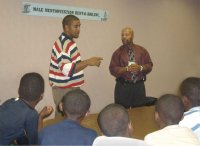Growing up in rural Elgin County, I frequently saw and occasionally interacted with the Amish who live in the area. Their community is a source of fascination for me. They are both a part of and separate from contemporary society. Their hard work and physical activity conflicts with the increasingly slothful lifestyle of their “English” counterparts. Yet, they continue the practice of limiting schooling to the eighth grade believing that “any more education would be harmful to their way of life” (Haddix, 2005). Despite this, and perhaps surprisingly, the Amish can be frequent library users. For example:
The Geauga/Trumbull County Amish settlement is the second largest in Ohio and the 4th largest in the world. We estimate that approximately 50% of the customers we serve at the Middlefield Library are Amish. They are avid readers and read primarily for entertainment. We check out a large amount of inspirational fiction, westerns, and comic books. They also enjoy reading about historical figures and events. The children enjoy classic titles such as Curious George or Old Yeller (Sue Becker, personal communication, February 28, 2008).
Amish teens, then, would make the ideal constituency for the Young Adult librarian if only libraries were more accessible by horse and buggy.
I blogged yesterday about the crisis facing young men who are increasingly delaying adulthood. For all their differences, the Amish, too, face a time of great personal, emotional and intellectual struggle. Called rumspringa, this is the period in an Amish teen’s life when they are freed from the usual constraints of the community. They are allowed to experience the outside world to decide if they want to remain Amish.
We spoke in class recently about multiple literacies and the Amish would make an interesting case study. Their lives are devoid of most of the technological advances that we take for granted. It is during rumspringa that Amish teens get their first exposure to telephones, television and the internet.

Kellner (n.d.) discusses these issues:
Sometimes “the media” are lumped into one homogeneous category, but it is important to discern that there are many media of communication and forms of cultural pedagogy, ranging from print media such as books, newspapers, and magazines to film, radio, television, popular music, photography, advertising, and many other multimedia cultural forms, including video
games, computer culture, CD-Roms, and the like.
Media literacy thus requires traditional print literacy skills as well as visual literacy, aural literacy, and the ability to analyze narratives, spectacles, and a wide range of cultural forms. Since media are a central part of our cultural experience from childhood to the grave, training in media literacy should begin early in life and continue into adulthood, as new technologies are constantly creating new media and new genres, technical innovations, aesthetic forms, and conventions are constantly emerging.
There is…the danger that youth will become totally immersed in a new world of hightech experience and lose its social connectedness and ability to interpersonally communicate and relate concretely to other people.
The conclusion of the quote is a particularly apt warning about the risks for Amish teens. Communication is extremely important to the Amish and the reason why they shun telephones. They distrust technology which they feel can be deceptive and rely on face-to-face conversation as a means of judging an individual’s motives. Amish teens lack the training Kellner describes and can become overwhelmed as they try to navigate a world that appears foreign although it surrounds them throughout their childhood.
Amish youth could generally be said to posses, at most, one form of literacy and it does not advance beyond an eighth grade level. This may be an explanation for why the Amish population is surging, with “retention rates of 85 percent or higher” (Burke, 2008). This figure suggests that, without any preparation, encountering so much technology at such a crucial time in their development leads them to often return to the safety of the community. This deprives them of potentially far greater opportunities outside the Amish community. Or, as the conclusion of the above video indicates, when they choose to permanently leave it is often accompanied by conflict with the new world they are experiencing.
This is not to imply that the Amish are unhappy. In fact, studies suggest the opposite. “Their depression rates are negligibly low relative to the rest of societys. Their happiness levels are consistently high” (Surowiecki, 2005). But it must be asked if they are truly enjoying a high quality of life.
References:
Burke, D. (2008, October 11). Surging Amish spreading out. The Washington Post. Retrieved October 23, 2008, from:
http://www.washingtonpost.com/wp-dyn/content/article/2008/10/10/AR2008101002884.html
Haddix, G.L. (2005). A historical overview of Amish education in Lawrence County, Tennessee. (Doctoral dissertation, Tennessee State University.) Retrieved October 23, 2008, from: http://e-research.tnstate.edu/dissertations/AAI3187591
Kellner, D. (n.d.). Multiple Literacies and Critical Pedagogy in a Multicultural Society.
Retrieved October 23, 2008, from: http://www.gseis.ucla.edu/faculty/kellner/essays/multipleliteraciescriticalpedagogy.pdf
Surowiecki, J. (2005). Technology and happiness. Technology Review. Retrieved October 23, 2008, from:
http://www.technologyreview.com/BioTech/14091/
Posted in Uncategorized



































 One of the problems is a lack of suitable role models for boys as they grow up. This problem is recognized in the school system. In a report by Ontario educators, the province was urged to “act immediately to boost the already low and rapidly shrinking number of male teachers” (CBC, 2004).
One of the problems is a lack of suitable role models for boys as they grow up. This problem is recognized in the school system. In a report by Ontario educators, the province was urged to “act immediately to boost the already low and rapidly shrinking number of male teachers” (CBC, 2004). exposure to a teacher typically lasts only one year. Furthermore, boys are required to go to school. Yet it is often observed that boys are not physically present in the library. There is some exciting and innovative library programming to address this issue. The ALA awarded its 2007 Diversity Award to Break-4-Boys: Male-2-Male Mentoring in which men speak and do activities with tweens and teens (ages 11–18) on a consistent basis. Mentorship is performed free for males by males (Nichols & Wilcox, 2007).
exposure to a teacher typically lasts only one year. Furthermore, boys are required to go to school. Yet it is often observed that boys are not physically present in the library. There is some exciting and innovative library programming to address this issue. The ALA awarded its 2007 Diversity Award to Break-4-Boys: Male-2-Male Mentoring in which men speak and do activities with tweens and teens (ages 11–18) on a consistent basis. Mentorship is performed free for males by males (Nichols & Wilcox, 2007).

I came across an interesting article about this very topic.
Hughes-Hassel, S. Hanson-Baldauf, D. Burke, J.E. (2008). Urban teenagers, health information, and public library web sites. Young Adult Library Services, 6(4), 35-43.
mdb,
Thank you for letting me know about that article. I will look at that article when I get a chance!